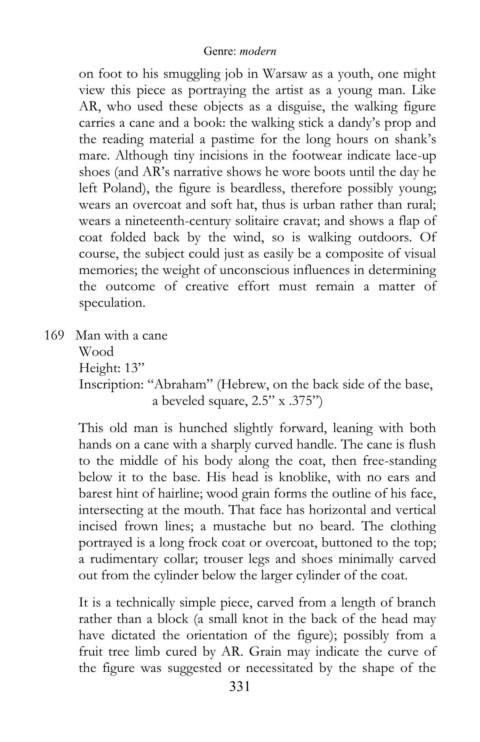Page 335 - The Legacy of Abraham Rothstein - text
P. 335
Genre: modern
on foot to his smuggling job in Warsaw as a youth, one might
view this piece as portraying the artist as a young man. Like
AR, who used these objects as a disguise, the walking figure
carries a cane and a book: the walking stick a dandy’s prop and
the reading material a pastime for the long hours on shank’s
mare. Although tiny incisions in the footwear indicate lace-up
shoes (and AR’s narrative shows he wore boots until the day he
left Poland), the figure is beardless, therefore possibly young;
wears an overcoat and soft hat, thus is urban rather than rural;
wears a nineteenth-century solitaire cravat; and shows a flap of
coat folded back by the wind, so is walking outdoors. Of
course, the subject could just as easily be a composite of visual
memories; the weight of unconscious influences in determining
the outcome of creative effort must remain a matter of
speculation.
169 Man with a cane
Wood
Height: 13”
Inscription: “Abraham” (Hebrew, on the back side of the base,
a beveled square, 2.5” x .375”)
This old man is hunched slightly forward, leaning with both
hands on a cane with a sharply curved handle. The cane is flush
to the middle of his body along the coat, then free-standing
below it to the base. His head is knoblike, with no ears and
barest hint of hairline; wood grain forms the outline of his face,
intersecting at the mouth. That face has horizontal and vertical
incised frown lines; a mustache but no beard. The clothing
portrayed is a long frock coat or overcoat, buttoned to the top;
a rudimentary collar; trouser legs and shoes minimally carved
out from the cylinder below the larger cylinder of the coat.
It is a technically simple piece, carved from a length of branch
rather than a block (a small knot in the back of the head may
have dictated the orientation of the figure); possibly from a
fruit tree limb cured by AR. Grain may indicate the curve of
the figure was suggested or necessitated by the shape of the
331

